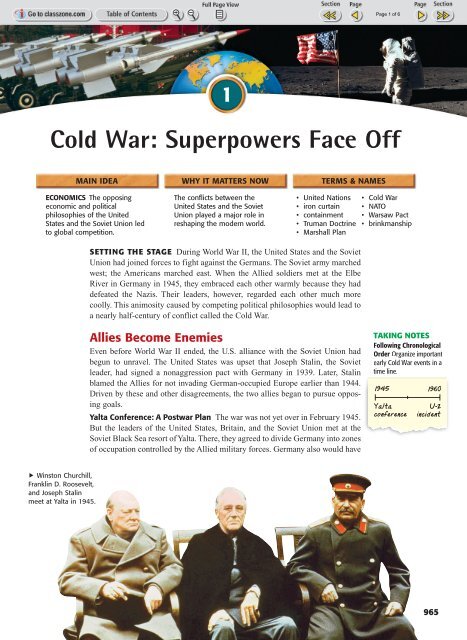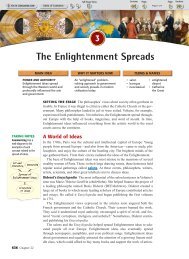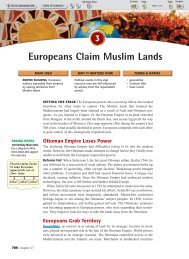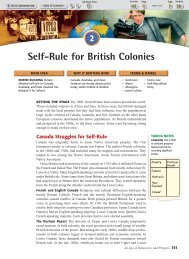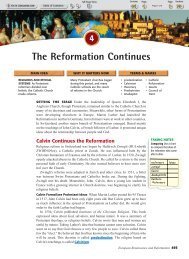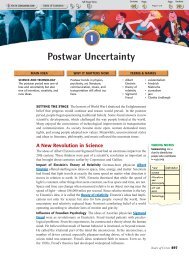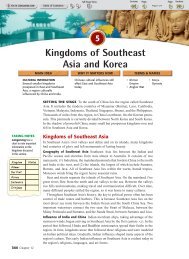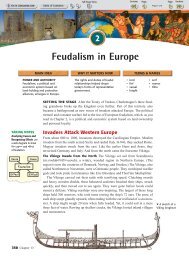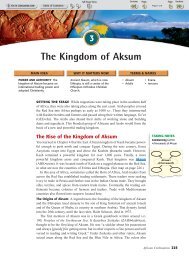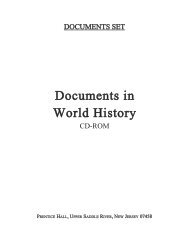Cold War: Superpowers Face Off - Mr. Trainor's Page
Cold War: Superpowers Face Off - Mr. Trainor's Page
Cold War: Superpowers Face Off - Mr. Trainor's Page
Create successful ePaper yourself
Turn your PDF publications into a flip-book with our unique Google optimized e-Paper software.
1<strong>Cold</strong> <strong>War</strong>: <strong>Superpowers</strong> <strong>Face</strong> <strong>Off</strong>MAIN IDEA WHY IT MATTERS NOW TERMS & NAMESECONOMICS The opposingeconomic and politicalphilosophies of the UnitedStates and the Soviet Union ledto global competition.The conflicts between theUnited States and the SovietUnion played a major role inreshaping the modern world.• United Nations• iron curtain• containment• Truman Doctrine• Marshall Plan• <strong>Cold</strong> <strong>War</strong>• NATO• <strong>War</strong>saw Pact• brinkmanshipSETTING THE STAGE During World <strong>War</strong> II, the United States and the SovietUnion had joined forces to fight against the Germans. The Soviet army marchedwest; the Americans marched east. When the Allied soldiers met at the ElbeRiver in Germany in 1945, they embraced each other warmly because they haddefeated the Nazis. Their leaders, however, regarded each other much morecoolly. This animosity caused by competing political philosophies would lead toa nearly half-century of conflict called the <strong>Cold</strong> <strong>War</strong>.Allies Become EnemiesEven before World <strong>War</strong> II ended, the U.S. alliance with the Soviet Union hadbegun to unravel. The United States was upset that Joseph Stalin, the Sovietleader, had signed a nonaggression pact with Germany in 1939. Later, Stalinblamed the Allies for not invading German-occupied Europe earlier than 1944.Driven by these and other disagreements, the two allies began to pursue opposinggoals.Yalta Conference: A Postwar Plan The war was not yet over in February 1945.But the leaders of the United States, Britain, and the Soviet Union met at theSoviet Black Sea resort of Yalta. There, they agreed to divide Germany into zonesof occupation controlled by the Allied military forces. Germany also would haveTAKING NOTESFollowing ChronologicalOrder Organize importantearly <strong>Cold</strong> <strong>War</strong> events in atime line.1945Yaltaconference1960U-2incidentWinston Churchill,Franklin D. Roosevelt,and Joseph Stalinmeet at Yalta in 1945.▲965
to pay the Soviet Union to compensate for its loss of life and property. Stalin agreedto join the war against Japan. He also promised that Eastern Europeans would havefree elections. A skeptical Winston Churchill predicted that Stalin would keep hispledge only if the Eastern Europeans followed “a policy friendly to Russia.”Creation of the United Nations In June 1945, the United States and the SovietUnion temporarily set aside their differences. They joined 48 other countries informing the United Nations (UN). This international organization was intended toprotect the members against aggression. It was to be based in New York.The charter for the new peacekeeping organization established a large bodycalled the General Assembly. There, each UN member nation could cast its vote ona broad range of issues. An 11-member body called the Security Council had thereal power to investigate and settle disputes, though. Its five permanent memberswere Britain, China, France, the United States, and the Soviet Union. Each couldveto any Security Council action. This provision was intended to prevent any membersof the Council from voting as a bloc to override the others.Differing U.S. and Soviet Goals Despite agreement at Yalta and their presenceon the Security Council, the United States and the Soviet Union split sharply afterthe war. The war had affected them very differently. The United States, the world’srichest and most powerful country, suffered 400,000 deaths. But its cities and factoriesremained intact. The Soviet Union had at least 50 times as many fatalities.One in four Soviets was wounded or killed. Also, many Soviet cities were demolished.These contrasting situations, as well as political and economic differences,affected the two countries’ postwar goals. (See chart below.)SummarizingWhy did theUnited States andthe Soviet Unionsplit after the war?United States• Encourage democracy in other countries to helpprevent the rise of Communist governments• Gain access to raw materials and markets to fuelbooming industries• Rebuild European governments to promotestability and create new markets for U.S. goods• Reunite Germany to stabilize it and increase thesecurity of EuropeSoviet Union• Encourage communism in other countries as partof a worldwide workers’ revolution• Rebuild its war-ravaged economy using EasternEurope’s industrial equipment and raw materials• Control Eastern Europe to protect Soviet bordersand balance the U.S. influence in Western Europe• Keep Germany divided to prevent its wagingwar again966 Chapter 33SKILLBUILDER: Interpreting Maps and Charts1. Drawing Conclusions Which countries separated the Soviet Union fromWestern Europe?2. Comparing Which U.S. and Soviet aims in Europe conflicted?
Eastern Europe’s Iron CurtainA major goal of the Soviet Union was to shield itself fromanother invasion from the west. Centuries of history hadtaught the Soviets to fear invasion. Because it lacked naturalwestern borders, Russia fell victim to each of its neighbors inturn. In the 17th century, the Poles captured the Kremlin.During the next century, the Swedes attacked. Napoleon overranMoscow in 1812. The Germans invaded Russia duringWorld <strong>War</strong>s I and II.Soviets Build a Buffer As World <strong>War</strong> II drew to a close, theSoviet troops pushed the Nazis back across Eastern Europe.At war’s end, these troops occupied a strip of countries alongthe Soviet Union’s own western border. Stalin regarded thesecountries as a necessary buffer, or wall of protection. Heignored the Yalta agreement and installed or securedCommunist governments in Albania, Bulgaria, Hungary,Czechoslovakia, Romania, Poland, and Yugoslavia.The Soviet leader’s American partner at Yalta, Franklin D.Roosevelt, had died on April 12, 1945. To Roosevelt’s successor,Harry S. Truman, Stalin’s reluctance to allow free elections in EasternEuropean nations was a clear violation of those countries’ rights. Truman, Stalin,and Churchill met at Potsdam, Germany, in July 1945. There, Truman pressedStalin to permit free elections in Eastern Europe. The Soviet leader refused. In aspeech in early 1946, Stalin declared that communism and capitalism could notexist in the same world.An Iron Curtain Divides East and West Europe now lay divided between Eastand West. Germany had been split into two sections. The Soviets controlled theeastern part, including half of the capital, Berlin. Under a Communist government,East Germany was named the German Democratic Republic. The western zonesbecame the Federal Republic of Germany in 1949. Winston Churchill described thedivision of Europe:▲ The Iron Curtainis shown droppingon Czechoslovakiain this 1948political cartoon.AnalyzingPrimary SourcesWhy mightWinston Churchilluse “iron curtain”to refer to thedivision betweenWestern andEastern Europe?PRIMARY SOURCEFrom Stettin in the Baltic to Trieste in the Adriatic, an iron curtain has descended acrossthe continent. Behind that line lie all the capitals of the ancient states of Central andEastern Europe. . . . All these famous cities and the populations around them lie in theSoviet sphere and all are subject in one form or another, not only to Soviet influencebut to a very high and increasing measure of control from Moscow.WINSTON CHURCHILL, “Iron Curtain” speech, March 5, 1946Churchill’s phrase “iron curtain” came to represent Europe’s division intomostly democratic Western Europe and Communist Eastern Europe.United States Tries to Contain SovietsU.S.-Soviet relations continued to worsen in 1946 and 1947. An increasingly worriedUnited States tried to offset the growing Soviet threat to Eastern Europe.President Truman adopted a foreign policy called containment. It was a policydirected at blocking Soviet influence and stopping the expansion of communism.Containment policies included forming alliances and helping weak countries resistSoviet advances.Restructuring the Postwar World 967
The Truman Doctrine In a speech asking Congress for foreign aid for Turkey andGreece, Truman contrasted democracy with communism:PRIMARY SOURCEOne way of life is based upon the will of the majority, and is distinguished by freeinstitutions . . . free elections . . . and freedom from political oppression. The second wayof life is based upon the will of a minority forcibly imposed upon the majority. It reliesupon terror and oppression . . . fixed elections, and the suppression of personalfreedoms. I believe it must be the policy of the United States to support free people . . .resisting attempted subjugation [control] by armed minorities or by outside pressures.PRESIDENT HARRY S. TRUMAN, speech to Congress, March 12, 1947Truman’s support for countries that rejected communism was called the TrumanDoctrine. It caused great controversy. Some opponents objected to American interferencein other nations’ affairs. Others argued that the United States could notafford to carry on a global crusade against communism. Congress, however,immediately authorized more than $400 million in aid to Turkey and Greece.The Marshall Plan Much of Western Europe lay in ruins after the war. There wasalso economic turmoil—a scarcity of jobs and food. In 1947, U.S. Secretary ofState George Marshall proposed that the United States give aid to needy Europeancountries. This assistance program, called the Marshall Plan, would provide food,machinery, and other materials to rebuild Western Europe. (See chart.) AsCongress debated the $12.5 billion program in 1948, the Communists seized powerin Czechoslovakia. Congress immediately voted approval. The plan was a spectacularsuccess. Even Communist Yugoslavia received aid after it broke away fromSoviet domination.Making InferencesWhat wasTruman’s major reasonfor offering aidto other countries?Countries Aided by the Marshall Plan, 1948–19513000Millions of Dollars250020001500100050002,826Great Britain2,4451,316FranceItaly1,297877West GermanyHollandAustria561 547 515Belgium/Lux.257 237 153 146 119 51 33 29GreeceDenmarkNorwayTurkeyIrelandSwedenPortugal350YugoslaviaIcelandOtherSource: Problèmes Économiques No. 306SKILLBUILDER: Interpreting Charts1. Drawing Conclusions Which country received the most aid from the United States?2. Making Inferences Why do you think Great Britain and France received so much aid?968 Chapter 33The Berlin Airlift While Europe began rebuilding, the United States and its alliesclashed with the Soviet Union over Germany. The Soviets wanted to keep their formerenemy weak and divided. But in 1948, France, Britain, and the United Statesdecided to withdraw their forces from Germany and allow their occupation zonesto form one nation. The Soviet Union responded by holding West Berlin hostage.Although Berlin lay well within the Soviet occupation zone of Germany, ittoo had been divided into four zones. (See map on next page.) The Soviet Unioncut off highway, water, and rail traffic into Berlin’s western zones. The city facedstarvation. Stalin gambled that the Allies would surrender West Berlin or give up
16° EThe Berlin AirliftFrom June 1948 to May 1949, Allied planestook off and landed every three minutes inWest Berlin. On 278,000 flights, pilots broughtin 2.3 million tons of food, fuel, medicine, andeven Christmas gifts to West Berliners.Divided Germany, 1948–1949TegelBERLINDENMARKGatow TempelhofHamburgNETH.HanoverBELG.WESTGERMANYEASTGERMANY50° NLUX.MainzCZECHOSLOVAKIAFRANCEFreiburgSWITZ.0 200 Miles8° EBaden-BadenMunich0 400 KilometersITALYAUSTRIAOccupation zonesBritishFrenchSovietU.S.Air corridorAirportSummarizingWhat Sovietactions led to theBerlin airlift?their idea of reunifying Germany. But American and British officials flew food andsupplies into West Berlin for nearly 11 months. In May 1949, the Soviet Unionadmitted defeat and lifted the blockade.The <strong>Cold</strong> <strong>War</strong> Divides the WorldThese conflicts marked the start of the <strong>Cold</strong> <strong>War</strong> between the United States and theSoviet Union. A cold war is a struggle over political differences carried on bymeans short of military action or war. Beginning in 1949, the superpowers usedspying, propaganda, diplomacy, and secret operations in their dealings with eachother. Much of the world allied with one side or the other. In fact, until the SovietUnion finally broke up in 1991, the <strong>Cold</strong> <strong>War</strong> dictated not only U.S. and Soviet foreignpolicy, but influenced world alliances as well.<strong>Superpowers</strong> Form Rival Alliances The Berlin blockade heightened WesternEurope’s fears of Soviet aggression. As a result, in 1949, ten western Europeannations joined with the United States and Canada to form a defensive militaryalliance. It was called the North Atlantic Treaty Organization (NATO). An attack onany NATO member would be met with armed force by all member nations.The Soviet Union saw NATO as a threat and formed it’s own alliance in 1955. Itwas called the <strong>War</strong>saw Pact and included the Soviet Union, East Germany,Czechoslovakia, Poland, Hungary, Romania, Bulgaria, and Albania. In 1961, the EastGermans built a wall to separate East and West Berlin. The Berlin Wall symbolizeda world divided into rival camps. However, not every country joined the newalliances. Some, like India, chose not to align with either side. And China, the largestCommunist country, came to distrust the Soviet Union. It remained nonaligned.The Threat of Nuclear <strong>War</strong> As these alliances were forming, the <strong>Cold</strong> <strong>War</strong>threatened to heat up enough to destroy the world. The United States already hadatomic bombs. In 1949, the Soviet Union exploded its own atomic weapon.President Truman was determined to develop a more deadly weapon before theSoviets did. He authorized work on a thermonuclear weapon in 1950.Restructuring the Postwar World 969
The hydrogen or H-bomb would be thousands of times more powerful than theA-bomb. Its power came from the fusion, or joining together, of atoms, rather thanthe splitting of atoms, as in the A-bomb. In 1952, the United States tested the firstH-bomb. The Soviets exploded their own in 1953.Dwight D. Eisenhower became the U.S. president in 1953. He appointed thefirmly anti-Communist John Foster Dulles as his secretary of state. If the SovietUnion or its supporters attacked U.S. interests, Dulles threatened, the United Stateswould “retaliate instantly, by means and at places of our own choosing.” This willingnessto go to the brink, or edge, of war became known as brinkmanship.Brinkmanship required a reliable source of nuclear weapons and airplanes todeliver them. So, the United States strengthened its air force and began producingstockpiles of nuclear weapons. The Soviet Union responded with its own militarybuildup, beginning an arms race that would go on for four decades.The <strong>Cold</strong> <strong>War</strong> in the Skies The <strong>Cold</strong> <strong>War</strong> also affected the science and educationprograms of the two countries. In August 1957, the Soviets announced the developmentof a rocket that could travel great distances—an intercontinental ballistic missile,or ICBM. On October 4, the Soviets used an ICBM to push Sputnik, the firstunmanned satellite, above the earth’s atmosphere. Americans felt they had fallenbehind in science and technology, and the government poured money into scienceeducation. In 1958, the United States launched its own satellite.In 1960, the skies again provided the arena for a superpower conflict. Five yearsearlier, Eisenhower had proposed that the United States and the Soviet Union beable to fly over each other’s territory to guard against surprise nuclear attacks. TheSoviet Union said no. In response, the U.S. Central Intelligence Agency (CIA)started secret high-altitude spy flights over Soviet territory in planes called U-2s.In May 1960, the Soviets shot down a U-2 plane, and its pilot, Francis GaryPowers, was captured. This U-2 incident heightened <strong>Cold</strong> <strong>War</strong> tensions.While Soviet Communists were squaring off against the United States,Communists in China were fighting a civil war for control of that country.RecognizingEffectsHow did theU.S. policy of brinkmanshipcontributeto the arms race?SECTION1ASSESSMENTTERMS & NAMES 1. For each term or name, write a sentence explaining its significance.• United Nations • iron curtain • containment • Truman Doctrine • Marshall Plan • <strong>Cold</strong> <strong>War</strong> • NATO • <strong>War</strong>saw Pact • brinkmanshipUSING YOUR NOTES2. Which effect of the <strong>Cold</strong> <strong>War</strong>was the most significant?Explain.1945Yaltaconference1960U-2incidentMAIN IDEAS3. What was the purpose informing the United Nations?4. What was the goal of theMarshall Plan?5. What were the goals of NATOand the <strong>War</strong>saw Pact?CRITICAL THINKING & WRITING6. COMPARING AND CONTRASTING What factors help toexplain why the United States and the Soviet Unionbecame rivals instead of allies?7. ANALYZING MOTIVES What were Stalin’s objectives insupporting Communist governments in Eastern Europe?8. ANALYZING ISSUES Why might Berlin be a likely spot fortrouble to develop during the <strong>Cold</strong> <strong>War</strong>?9. WRITING ACTIVITY ECONOMICS Draw a political cartoonthat shows either capitalism from the Soviet point of viewor communism from the U.S. point of view.970 Chapter 33INTERNET ACTIVITYUse the Internet to research NATO today. Prepare a chart listingmembers today and the date they joined. Then compare it with a listof the founding members.INTERNET KEYWORDNorth Atlantic TreatyOrganization


